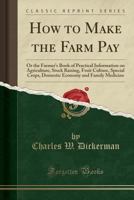How to Make the Farm Pay: Or, The Farmer's Book of Practical Information on Agriculture, Stock Raising, Fruit Culture, Special Crops, Domestic Economy & Family Medicine
Select Format
Select Condition 
Based on Your Recent Browsing
Book Overview
A practical guide for farmers, offering advice on everything from planting and harvesting crops to managing livestock and maintaining a healthy home. This book is a valuable resource for anyone seeking to maximize their farm's profitability.
This work has been selected by scholars as being culturally important, and is part of the knowledge base of civilization as we know it.
This work is in the "public domain in the United States of America, and possibly other nations. Within the United States, you may freely copy and distribute this work, as no entity (individual or corporate) has a copyright on the body of the work.
Scholars believe, and we concur, that this work is important enough to be preserved, reproduced, and made generally available to the public. We appreciate your support of the preservation process, and thank you for being an important part of keeping this knowledge alive and relevant.



























![Manual of Agriculture [Electronic Resource]: For the School, the Farm, and the Fireside](https://i.thriftbooks.com/api/imagehandler/s/C37A332F5494F10FBBE946139D50BA8D2FCAF81A.jpeg)

















